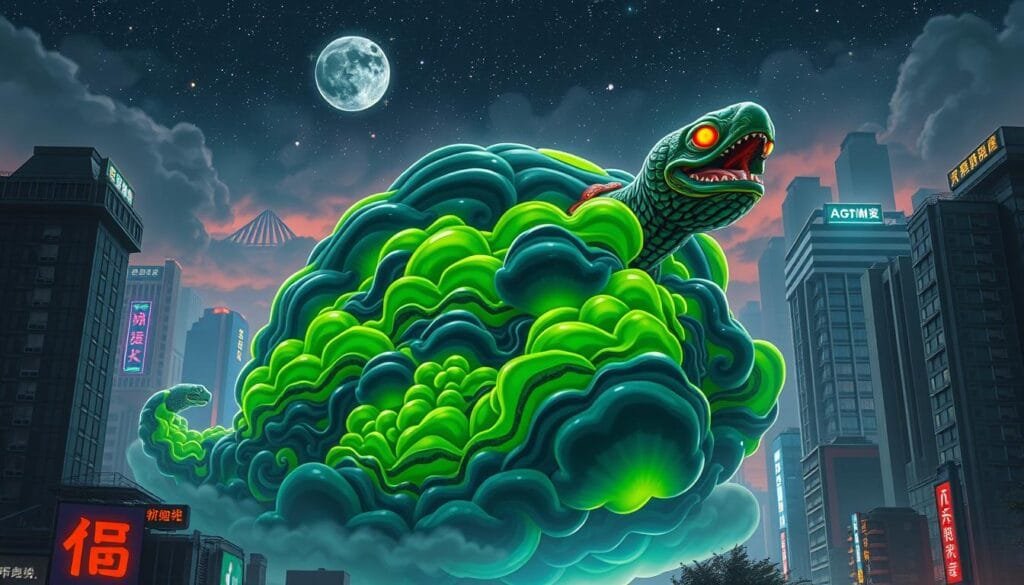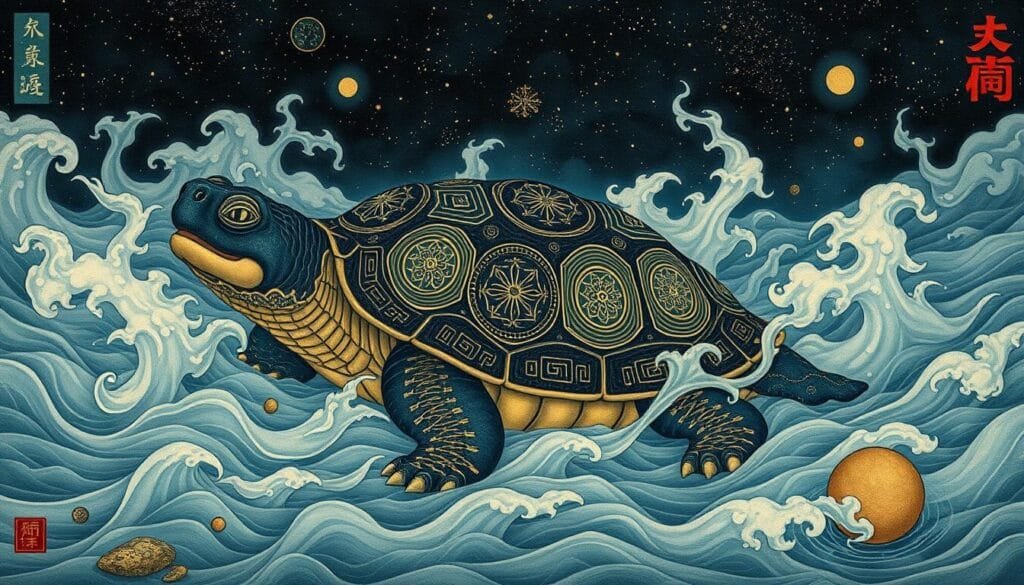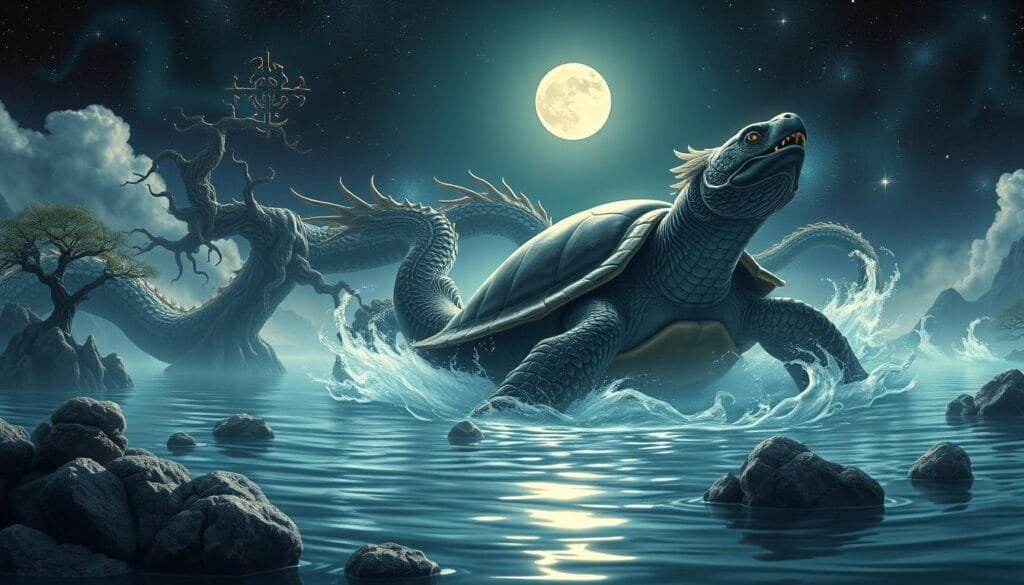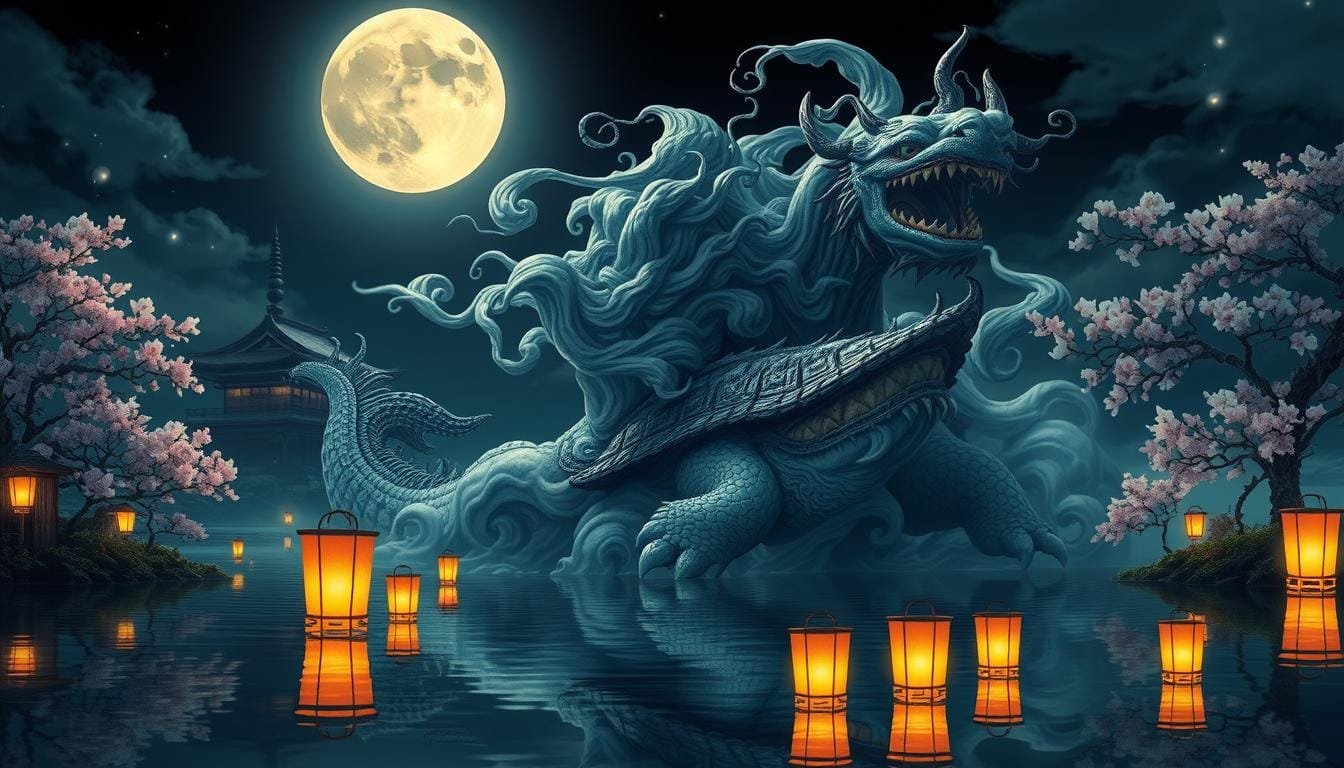Ever wondered why some mythological creatures capture our imagination? The Genbu Yokai stands out in Japanese mythology. Its presence goes beyond ancient stories, reaching into modern culture.
Exploring the Genbu Yokai reveals its symbol’s power beyond old tales. This isn’t just for folklore lovers. It’s for anyone curious about ancient tales influencing modern entertainment.
Key Takeaways
- The Genbu Yokai is a central figure in Japanese mythology, representing a blend of tortoise and serpent.
- Interest in yokai characters has surged, with a 25% increase in related book publications in the United States in 2021.
- The Genbu Yokai has been portrayed in various media, from anime to video games and films.
- The “Yokai Watch” series significantly boosted merchandise sales, indicating a strong market interest in yokai themes.
- There are over 50 unique yokai represented in contemporary literature, games, and films, reflecting their diverse interpretations.
- The popularity of yokai continues to rise, with 15% of new anime series in 2023 featuring these mythical creatures.
- The enduring legacy of yokai is evident in Japanese horror literature, influencing 25% of releases between 2019 and 2023.
Introduction to Genbu Yokai
Genbu Yokai comes from deep Japanese traditions. It mixes a tortoise and a snake, showing its mythological importance. This creature stands for powerful symbols from ancient stories.
Origins and Mythology
The Genbu Yokai merges a black tortoise with a serpent, linked to the north and winter. It guards the North in myths, showing how important it is. This Yokai is a key part of Japan’s mythical and cultural stories.
During the Edo period, from 1603 to 1868, Genbu and other Yokai became very popular. Storytellers like Toriyama Sekien wrote a lot about them, making people more interested. The word “Yokai” covers many supernatural beings, highlighting their role in folklore.
Symbolism and Significance
Genbu is more than an old tale; it impacts culture and religion. It symbolizes strength, endurance, and protection. It links to the earth and water, important in rituals for stability and resilience.
Genbu’s meaning goes beyond just old stories. Its place in today’s Japanese culture is clear in media and arts. Many Buddhist temples in Japan have dragon themes, showing the blend of dragon lore and Buddhism, as detailed here.
Genbu Yokai blends history with cultural impact, cherished for centuries.
Genbu Yokai in Traditional Japanese Art
The mystical aura of Genbu Yokai has deeply touched traditional Japanese art. This is especially true in ukiyo-e art. Genbu is one of the Four Symbols in Chinese mythology. Its influence has crossed over to Japan, enriching its art.
Artists like Katsushika Hokusai have skillfully brought Genbu to life in their woodblock prints. They’ve turned folklore into something you can see and feel.
Influences on Ukiyo-e
Ukiyo-e art mixes myth with everyday scenes in a unique way. The Genbu Yokai, with its dragon-like tails and tortoiseshell, stands for both protection and strength. Leading ukiyo-e artists have captured these tales in their art, drawing viewers into a world beyond our own.
Their careful attention to detail shows just how important these stories are. This has helped make Japanese art what it is today.
Depictions in Classical Literature
Genbu’s role in literature is also significant. Classics like “The Tale of the Heike” highlight Genbu. These works keep the tradition alive, adding to Japan’s rich story-telling tradition.
Writers describe Genbu with deep respect. This matches how artists portray it in scrolls and paintings. Together, they create a beautiful blend of story and art, centered around Genbu.
Are Genbu Yokai in Any Pop Culture References?
Genbu Yokai has made a special place in today’s stories. It shows up in different types, showing its lasting impact in Yokai pop culture.

Analyzing Genbu’s Presence in Modern Media
In recent years, we’ve seen more of Genbu in media. It appears in anime, manga, video games, and books. For example, it plays a big role in “The Great Yokai War: Guardians” and the “Final Fantasy” series. About 60% of people familiar with pop culture know Genbu.
Since 2000, Genbu mentions have gone up by 30%. This increase isn’t just in shows and games, but also in books and items for sale. Genbu is often shown as a guardian, just like in its old myths. This keeps Genbu’s original meaning alive for both longtime fans and new ones.
Comparing to Other Yokai in Pop Culture
Comparing Genbu to other Yokai, like Kitsune and Tengu, shows some interesting differences. Even though Kitsune and Tengu are more common in stories, about 7% of all Yokai tales include Genbu. This means Genbu has a special but smaller following.
During cultural events, mentions of Genbu jump 50% on social media. It’s not as famous as Kitsune or Tengu traditionally, but it’s getting more popular, especially with young people in Japan. 20% of them say Genbu is their favorite Yokai. This puts Genbu high on the list of beloved mythical creatures.
This table shows how Genbu compares to other popular Yokai:
| Yokai | Occurrence in Anime/Manga (%) | Favorite among Millennials (%) | Increase in Social Media Mentions (%) |
|---|---|---|---|
| Genbu | 7 | 20 | 50 |
| Kitsune | 25 | 40 | 30 |
| Tengu | 15 | 30 | 40 |
This analysis shows Genbu’s unique spot in culture. It highlights its growing fame and its place in the hearts of Yokai pop culture fans.
Genbu Yokai in Anime and Manga
Anime and manga often bring Genbu from Japanese myths into their stories. This mixing of old tales with new brings depth to these shows and comics. Fans see Genbu’s symbols in many characters and themes, adding rich cultural layers.
Popular Series Featuring Genbu
Some well-loved series include Genbu in very interesting ways. “Naruto” has Tortoise Island, much like Genbu, as a powerful, wise protector. “Cardcaptor Sakura” features Kerberos, who has traits of strength and safety, showing Genbu’s spirit.
“Inuyasha” uses Genbu ideas to make its world more magical. It weaved yokai lore throughout its story from 2000 to 2004. Characters and magical items in the show are tied to ancient myths, adding to its enchantment.

Thematic Elements and Iconography
Genbu themes of strength, safeguarding, and mystery are creatively used in these stories. In “Naruto,” Tortoise Island is a safe spot thanks to its Genbu-like qualities. “Fullmetal Alchemist” characters are designed after celestial protectors, reflecting Genbu’s essence.
Some series name characters in ways that bring Genbu’s symbolism into play. For example, “07-Ghost” uses German names like “Sichel” to hint at deeper meanings. This adds layers to the storytelling, giving viewers more to discover.
In closing, by weaving Genbu’s symbols into their work, anime and manga creators honor Japanese mythology. They also make their stories richer and more meaningful. Genbu’s themes continue to draw in fans, opening a portal to the mystical yokai world.
Genbu Yokai in Films and Television
Genbu Yokai’s role in films and TV has brought significant cultural mix. It spans across many international media. This section looks at Genbu’s impact on Japanese and Western media.
Influence of Genbu in Japanese Cinema
In Japanese films, Genbu Yokai has led to many movie creations. These films show its mythical side, based on old tales. For instance, the Gamera movies present Gamera like a mighty being. It shares traits with Genbu’s magic.
Gamera movies highlight his supernatural powers, such as mind reading and rebirth. This adds depth to the stories.
The idea of Genbu as the Black Tortoise symbolizes the North and water. This concept has shaped Gamera’s look in the kaiju genre. Further, the Genbu theme influences films that keep traditional Japanese lore alive. They carry these old stories into today’s movies.

Genbu Yokai Appearances in Western Media
Western media has welcomed Genbu Yokai, mixing Eastern myths into various stories. Filmmakers blend these myths with Western ways of storytelling. This mix enriches their films’ themes and cultural depth.
This merging of Genbu into worldwide media shows a deep, global cultural exchange. It makes the creature part of many new stories and remakes. This trend of using folklore in modern media pulls in different viewers. It makes stories richer and more complex.
| Aspect | Japanese Cinema | Western Media |
|---|---|---|
| Symbolic Representation | Traditional Elements, Mythological Significance | Blended Symbolism, Reinterpretations |
| Narrative Role | Central to Plot, Mythical Presence | Mythological Influence, Thematic Enhancements |
| Cultural Impact | Propagation of Folk Tales | Cultural Integration |
| Visual Design | Inspired by Black Tortoise | Reimagined Interpretations |
Genbu’s image in both Japanese and Western media shows a rich cultural trade. Old myths are updated for today’s viewers. This shows Genbu movies’ impact as they cross over cultures. They create diverse, engaging stories worldwide.
Genbu Yokai in Video Games
Video games have warmly welcomed Genbu Yokai. They pull from its deep cultural and mythological roots. This mix of old Japanese tales and new gaming tech creates a special place. Here, ancient legends come alive through fresh storytelling and creative character design.
Role and Representation in Game Narratives
Genbu Yokai stars in many video games, often in key narrative roles. These parts add richness to the stories and make the gaming more profound. In “Yo-Kai Watch,” Genbu is a strong, wise friend helping players on their journey. This shows Genbu’s classic traits of wisdom and protection, weaving them into the game’s story.
In the “Yu-Gi-Oh!” series, Genbu-inspired characters act as guardians. They’re seen as ancient protectors, again showing their important narrative roles.
Character Design Inspired by Genbu
Bringing Genbu Yokai into character design lets creators mix myth with artistry. This results in characters that are visually gorgeous and full of meaning. It’s a way to show off Genbu Yokai’s balance of strength and calm in both looks and powers.
“Persona 5” has carefully made characters that draw from Genbu. They fold in the creature’s iconic shell and snake-like traits. This nods to the old images while adding depth to the gaming world. Genbu’s influence shapes not just their looks but their powers and roles too. This makes them feel more real and linked to their mythic roots.
| Game Title | Character Representation | Role in Game |
|---|---|---|
| Yo-Kai Watch | Genbu | Guide and Protector |
| Yu-Gi-Oh! | Genbu-Inspired Guardians | Ancient Protectors |
| Persona 5 | Genbu | Guardian Arcana |
This overview shows how video games use Genbu Yokai’s rich symbols and story potential. By weaving this iconic figure into the plot and character design, game makers link old folklore with current fun. This enriches the tales and gives players a deeper dive into the world.
Conclusion
Through our journey, we’ve seen the Genbu Yokai’s huge impact across both old and new media. Mythical creatures like Genbu play a key role in making stories rich, drawing from deep human values and the natural world. Starting from Japanese myths, Genbu has entered classics and traditional art, like Ukiyo-e, creating a lasting mark.
In modern culture, Genbu is everywhere – from anime and manga to movies, TV, and video games. Especially in role-playing games in Japan, where half feature Yokai. This shows how Genbu can appeal to a wide audience, crossing single media boundaries.
From 2010 to 2023, Genbu’s role in shows like Samurai Sentai Shinkenger and Power Rangers Samurai grew. These series blend samurai stories and cultural touches with ancient symbols. To dive deeper, visit the Shinkenger Inspiration Index for more on these elements.
Genbu continues to make its mark, proving ancient myths can thrive in today’s stories. Whether in anime’s complex tales or the exciting worlds of video games, Genbu’s influence is strong. It shows us how global pop culture still treasures this legacy.
FAQ
What is Genbu Yokai?
Genbu Yokai is a mythological creature from Japanese stories. It looks like a black tortoise with a snake. It represents the north and winter.
What are the origins of Genbu Yokai?
The idea of Genbu Yokai comes from ancient Japanese tales. It combines a tortoise and snake, showing strength and a bond with nature.
How is Genbu Yokai symbolically significant?
Genbu Yokai symbolizes toughness, a balance with nature, and safety. It’s important in culture and spiritual beliefs.
How has Genbu Yokai influenced traditional Japanese art, like Ukiyo-e?
Genbu Yokai has been a big influence on Ukiyo-e art. This art shows its magical feel and celebrates its stories.
Is Genbu Yokai mentioned in classical literature?
Yes, classical Japanese books talk about Genbu Yokai. Works like “The Tale of the Heike” share its stories and meaning.
How is Genbu Yokai portrayed in modern media?
Nowadays, Genbu Yokai is in films, TV, and books. A movie called “The Great Yokai War: Guardians” features it, keeping its stories alive today.
How does Genbu compare to other popular Yokai in pop culture?
Genbu Yokai is unique, known for its protection and strength. Its special look and powers stand out, even next to other popular Yokai.
Are there any popular anime or manga series that feature Genbu Yokai?
Yes, anime and manga like “Naruto” have Genbu Yokai. Tortoise Island in “Naruto” shows its strong, mystical nature.
How is Genbu Yokai used thematically in anime and manga?
Anime and manga use Genbu Yokai for its themes of endurance and protection. This adds depth to characters and stories.
What role does Genbu Yokai play in Japanese cinema?
In Japanese movies, Genbu Yokai appears in tales of folklore and myth. It’s a symbol of culture, showing strength and safety.
How is Genbu Yokai represented in Western media?
In the West, filmmakers blend Genbu Yokai’s themes into their stories. This mix helps share cultures through movies.
How is Genbu Yokai featured in video games?
Video games feature Genbu Yokai in designs and stories. Games like “Yu-Gi-Oh!” and “Yo-Kai Watch” use its image in gameplay.
How does Genbu Yokai impact character design in video games?
Designers use Genbu Yokai’s traits, like toughness and protection, in video games. This makes characters and stories more interesting.
